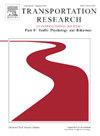The impact of information transparency in warning signs on drivers’ risk perception: Evidence from event-related potentials
IF 3.5
2区 工程技术
Q1 PSYCHOLOGY, APPLIED
Transportation Research Part F-Traffic Psychology and Behaviour
Pub Date : 2025-06-11
DOI:10.1016/j.trf.2025.06.007
引用次数: 0
Abstract
The Internet of Vehicles (IoV) enables real-time monitoring of driving behaviours and enhances road safety through vehicle-to-vehicle (V2V) communication. Effective warning systems play a crucial role in this context by transmitting safety information promptly. With the event-related potential technique, this study investigated how information transparency of warning signs influenced perceived risk (PR) in a simulated IoV environments. Specifically, factual and suggested warnings (high/low transparency, respectively) were experimentally compared. Factual signs convey actual situations detected by the IoV while suggested signs provide operational suggestions. Neuroscientific analysis reveals that factual signs triggered larger Late Positive Potentials (LPP), indicating heightened cognitive processing. Besides, drivers exhibited shorter reaction times, a preference for high-risk choices, and overall higher PR scores when exposed to factual warnings. Conclusion can be drawn that factual signs exhibit higher levels of PR compared to suggested signs. The findings can deepen the understanding of cognitive processing in risk information warnings, informing the development of safer IoV environments through improving V2V communication and enhancing warning design strategies.
警示牌信息透明度对驾驶员风险感知的影响:来自事件相关电位的证据
车联网(IoV)可以实时监控驾驶行为,并通过车对车(V2V)通信提高道路安全性。在这种情况下,有效的警报系统通过及时传递安全信息发挥着至关重要的作用。本研究利用事件相关电位技术,研究了在模拟车联网环境中,预警信号的信息透明度如何影响感知风险(PR)。具体来说,实验比较了事实警告和建议警告(分别为高/低透明度)。事实标志传达IoV检测到的实际情况,建议标志提供操作建议。神经科学分析表明,事实信号触发了更大的晚期正电位(LPP),表明认知加工增强。此外,司机在面对事实性警告时表现出更短的反应时间、对高风险选择的偏好,以及总体上更高的PR得分。可以得出结论,事实符号比暗示符号表现出更高水平的PR。研究结果可以加深对风险信息预警认知过程的理解,通过改善车对车通信和加强预警设计策略,为更安全的车联网环境的发展提供信息。
本文章由计算机程序翻译,如有差异,请以英文原文为准。
求助全文
约1分钟内获得全文
求助全文
来源期刊
CiteScore
7.60
自引率
14.60%
发文量
239
审稿时长
71 days
期刊介绍:
Transportation Research Part F: Traffic Psychology and Behaviour focuses on the behavioural and psychological aspects of traffic and transport. The aim of the journal is to enhance theory development, improve the quality of empirical studies and to stimulate the application of research findings in practice. TRF provides a focus and a means of communication for the considerable amount of research activities that are now being carried out in this field. The journal provides a forum for transportation researchers, psychologists, ergonomists, engineers and policy-makers with an interest in traffic and transport psychology.

 求助内容:
求助内容: 应助结果提醒方式:
应助结果提醒方式:


